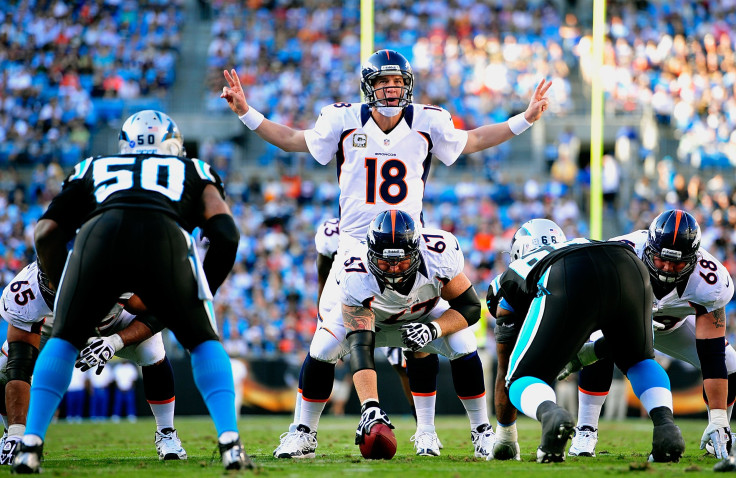Super Bowl 50 Live Stream: Watching The Broncos-Panthers Game On Your iPad Takes A Small Miracle

Two Sundays from now, Cam Newton and the Carolina Panthers will take on Peyton Manning and the Denver Broncos in Super Bowl 50. In order to show viewers all the glorious feats of athleticism that Newton is sure to perform, an awful lot of stuff — technical and otherwise — has to happen. The Carolina offensive line has to hold. A fleet of CBS cameras has to take in the images of what’s happening on the field. And a massive team of broadcast professionals has to immediately splice and dice footage and add in all the graphics.
And if you’re one of the 1 million to 2 million people who plan to live-stream the Super Bowl on a computer or mobile device, it gets even more complicated.
Creating a live stream isn’t as simple as feeding the broadcast signal for a game through a different tube. The video actually has to be encoded differently for transit over the internet. As if that weren’t complex enough, here’s an additional layer of complication: Because many advertisers buy digital impressions separately from regular TV viewers, the commercials you see during a given broadcast aren’t necessarily the ones you see during a live stream.
Media buyers and clients had been reluctant to fork over additional cash for digital impressions, meaning some of their ads were absent from past Super Bowl streams. But CBS, which is airing Super Bowl 50, has managed to convince advertisers of the added value of being in the live stream as well. So this year, for the first time, Super Bowl streamers will get to see all the same national ads as their traditional-viewer counterparts.
Until just a few years ago, the main barrier to live-streaming was internet bandwidth, says Matt Smith, the “Chief Evangelist” of the video streaming company Anvato, which helped Fox live-stream Super Bowl XLVIII in 2014. Once broadband and mobile speeds reached the point where they could handle transporting the massive amounts of data a video stream entails, the biggest barrier became something Smith dubs “the Codec Wars.”
Smith has been working on streaming tech for 16 years, since the days when you could only live-stream audio, at places like Yahoo and Envivio. “Even just a couple years ago, you had all these competing ways of encoding streaming video, it was a mess,” he says. Certain devices could only process streams encoded using one of several formats, including Microsoft’s SmoothStream, Adobe’s Flash and Apple’s HTTP Live Streaming. Once Apple’s codec beat the others into submission via popularity, the real work could begin, he adds.
Fox’s Super Bowl live stream saw an average of 528,000 streamers per minute and a peak of 1.1 million, or about 1 percent of the broadcast audience. In order to make sure all 1.1 million experienced a pristine stream, Anvato had three facilities encoding Fox’s signal in three different states, plus several different networks delivering the content.
That’s the most important part of being on the back end of a live stream, says Smith: “Redundancy, redundancy, redundancy.” In the event of a catastrophe at one of the encoding facilities, or a hiccup in the network being used to deliver the content to local internet service providers, Anvato would instantly switch to a backup. Thus, complaints about consistently bad streams should usually be directed toward your internet service provider, the company that handles transit of the information the last mile of its journey.
When you’re watching a live stream, a back-end provider like Anvato has to handle the stitching together of the entire “telecast,” using information encoded in the signal to see where ad breaks are. The software then makes a request from a digital ad network — generally either Google’s DoubleClick or Comcast’s FreeWheel — to see what ads should run, and in what order; the system then pulls the commercials from a folder on the server. (While we’re doing a bit of anthropomorphizing, all this is happening in near-instant fashion.)
Smith explains that the earlier reluctance of advertisers to participate in live streams wasn’t totally unfounded. “We had ads misfiring, and we couldn’t match the quality,” he says. “You’re watching a stream at good quality, maybe 2 or 3 Mbps, and then you see, say, a Sprite ad at 180 Kbps. It looked gruesome.”
But the times, they are a-changin’, as evidenced by CBS’ promise of a complete Super Bowl stream, ads and all. The issue of low-definition ads has largely been solved, and with more companies offering complete digital repackaging, the ability to make ad money on live streams is on the rise. Smith says one of Anvato’s broadcast clients was seeing just 25,000 ad requests per month at the beginning of 2015; by the end of the year, they were seeing 1.2 million ad requests per day.
While that’s not equivalent to 1.2 million streamers, as an ad request is made for each individual commercial, Smith says the increasing seamlessness of the technology has made it possible for content-makers, marketers and techies to join hands and sing “Kumbaya.”
“There is gold in that mine,” Smith says. “So start digging.”
© Copyright IBTimes 2024. All rights reserved.






















